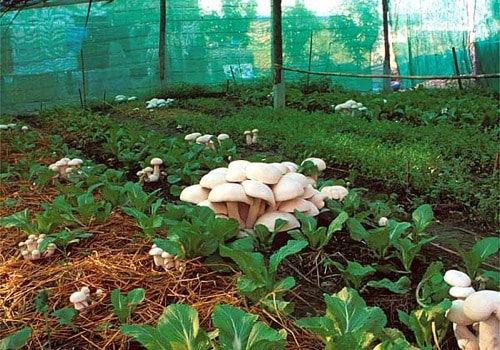- This topic is empty.
- AuthorPosts
- January 21, 2025 at 11:18 pm #543447

Mushroom housing is an innovative and sustainable approach to modern construction that uses mycelium, the root structure of mushrooms, as a building material.
With increasing concerns over environmental degradation, the rise of eco-conscious architecture, and the quest for alternative materials, mushroom housing has become an intriguing solution to reduce our carbon footprint.
In this article, we will explore the concept of mushroom housing, how it is made, its benefits, and its potential to transform the way we live in an environmentally responsible manner.
1. What Is Mushroom Housing?
Mushroom housing is a form of eco-friendly construction that utilizes mycelium, the dense network of root-like fibers produced by mushrooms, as a natural building material.
Mycelium is combined with organic matter such as agricultural waste, straw, or sawdust, which is then grown into molds to form bricks, insulation panels, or even entire structures.
The unique properties of mycelium make it lightweight, durable, and naturally resistant to fire, pests, and mold.
Additionally, it is biodegradable, making it a sustainable alternative to traditional construction materials like concrete, wood, and metal. The ability of mycelium to grow and take shape in specific molds allows for a wide range of architectural designs, from small homes to larger structures.
2. The Process of Creating Mushroom Housing
The process of creating mushroom housing begins with cultivating mycelium, which is grown in controlled conditions. Organic waste materials, such as sawdust, straw, or hemp, are used as a substrate for the mycelium to feed on. The mixture is placed into molds, where the mycelium takes root and binds the material together.
The growth process typically takes several days to a few weeks, depending on the size of the mold and the conditions. Once the mycelium has fully colonized the material, the resulting structure is dried and cured to halt further growth and ensure stability.
The final product is lightweight, strong, and highly insulating, making it ideal for use in construction. These mushroom-based materials are then used to build walls, insulation panels, and other components of a sustainable structure.
3. Benefits of Mushroom Housing
Mushroom housing offers numerous environmental and practical benefits that make it an attractive alternative to traditional building materials.
One of the most significant advantages is its sustainability. Unlike conventional materials like concrete and steel, mushroom-based construction uses organic, renewable resources that require minimal energy to produce.
Mycelium is also biodegradable, which means that structures made from mushroom housing materials won’t contribute to landfill waste once they reach the end of their lifecycle. A
dditionally, mushroom housing provides excellent thermal insulation, reducing the need for energy-intensive heating and cooling systems.
Mycelium’s natural properties also make it fire-resistant, mold-resistant, and pest-resistant, further enhancing the durability and safety of mushroom-based buildings.
These benefits make mushroom housing a key player in the push toward green building practices and sustainable living.
4. Applications of Mushroom Housing
Mushroom housing can be applied to a wide variety of construction projects, from single-family homes to larger commercial buildings and even temporary structures such as emergency shelters. The versatility of mycelium allows for creative architectural designs that can be molded into unique shapes and structures.
In addition to housing, mushroom-based materials are also being explored for their potential in creating furniture, insulation, and even packaging materials, providing a wide range of possibilities for sustainable products.
Researchers and architects are increasingly interested in incorporating mycelium into urban development, especially in areas where traditional construction materials are scarce or expensive.
The lightweight nature of mushroom-based materials makes them ideal for use in off-grid or disaster-prone areas, where quick, affordable, and eco-friendly housing solutions are needed.
5. The Future of Mushroom Housing
The future of mushroom housing looks promising as the demand for sustainable construction solutions grows. Advances in material science and the scaling up of mycelium production could make mushroom-based building materials more widely available and cost-effective.
As environmental concerns continue to rise, more architects, builders, and policymakers are beginning to recognize the potential of mycelium as a viable alternative to traditional construction materials.
The growing interest in sustainable living and green architecture, combined with the innovative potential of mushroom housing, positions this approach as a key player in the future of construction.
Additionally, as the technology to grow and harvest mycelium improves, mushroom housing could become an affordable and mainstream option for eco-conscious homeowners and developers alike.
Mushroom housing represents an exciting innovation in the field of sustainable construction, offering an environmentally friendly alternative to traditional building materials.
With its low environmental impact, natural durability, and biodegradability, it provides a unique solution to the challenges of modern housing.
As research and development in this field continue to advance, mushroom housing has the potential to revolutionize the way we think about building materials and design.
With the growing emphasis on sustainability and eco-conscious living, mushroom housing could become an integral part of the future of architecture, offering a greener, more sustainable way of living for generations to come.
Read Also:Benefits and importance of mushroom cultivation in modern farming
- AuthorPosts
- You must be logged in to reply to this topic.

